The Oxygen Advantage (OA) is a special nasal breathing technique originally developed by a Russian medical Doctor named Buyteko, transferred into the world of physical training and performance enhancement by Irishman Patrick McKeown. The technique aims for increased energy, more focus, improved resilience and to optimize your overall potential. McKeown says, that one of the secrets to weight loss, fitness and health lies in the most overlooked aspect of our life – how we breathe. And guess what, I think he’s absolutely right! I took his course and became one of the first Certified Oxygen Advantage Coaches in Germany. This article will give you a summary of how the OA works and where I see the benefits of switching from mouth to nose breathing. I will also discuss how the Oxygen Advantage differs from the Wim Hof Technique! —> Diesen Artikel gibt’s auch auf Deutsch <—
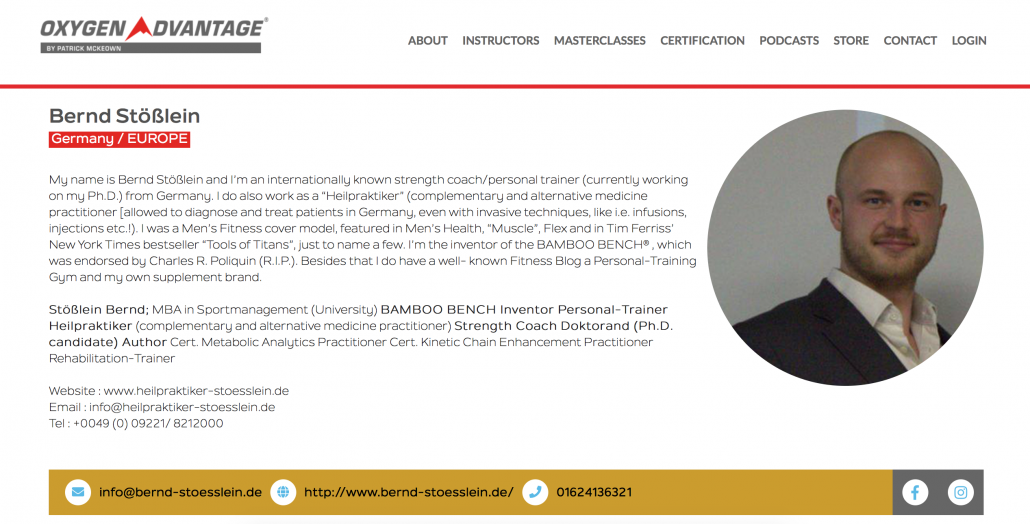
Slow but deep but light
OK, if you‘re new to the concept that you might not breathe “right”, you probably think something like: “I‘ve been breathing my whole life, cannot be that hard?!”. But wait, I was thinking the same!
But before we jump into the OA‘s technique right away it is necessary to think about the definition of some terms, in order for a better understanding how applying the OA works.
We will have a look about the following:
- Oxygen (O2)
- Hypoxial
- Hypercapnia
- Carbon Dioxide (CO2)
- SpO2
- Nitric Oxide (NO)
- pH-Level
- respiratory alkalosis
- respiratory acidosis
- Anatomy of the respiratory system
Oxygen:
Of course it‘s obvious that Oxygen might play an essential role in a program called the “Oxygen Advantage”. So what‘s Oxygen? Sure, we all heard about it in school but either we tend to forget or we didn‘t pay attention. As I want to stick to “K.I.S.S.” (keep it short and simple) and do not want to write an essay about how to star in “Breaking Bad”, here‘s a quick reminder:
“Oxygen is the chemical element with the symbol O and atomic number 8. It is a member of the chalcogen group in the periodic table, a highly reactive nonmetal, and an oxidizing agent that readily forms oxides with most elements as well as with other compounds. By mass, oxygen is the third-most abundant element in the universe, after hydrogen and helium. At standard temperature and pressure, two atoms of the element bind to form dioxygen, a colorless and odorless diatomic gas with the formula O. Diatomic oxygen gas constitutes 20.8% of the Earth’s atmosphere. As compounds including oxides, the element makes up almost half of the Earth’s crust.” (Wikipedia, 2019).
So, to make a long Oxygen story short, you need Oxygen to breathe and to live! So up till now nothing new under the sun you‘ll say. But hang on!
Hyp/oxia
If you have insufficient Oxygen you enter a state called hypoxia. This term derives from the Greek word “hyp(o)” = under, down and of course Greek: “oxys”= sharp, cutting, pointed (Becher et al., 1995). So hypoxia literally translated means: “too less air”.
Hyper/capnia
Again, to understand it‘s simply about decoding all those medical terms so that they‘ll lose their fright! Hypercapnia, surprise surprise also derives from Greek and is made up of the term “hyper” (which is the opposite of “hyp(o)”) = over, above and “kapnos” = smoke, steam, respectively: carbon dioxide (Becher et al., 1995).
So it‘s actually a quite simple term, saying, that you are having: “too much CO2”.
Carbon Dioxide (CO2) – Not just a waste gas!
Nowadays (especially so called “Millennials”) people tend to be followers, not uncommon in the world of social media and Co. Therefore CO2 has a bad reputation but I tell you what:
If it is so “bad” why is it used in greenhouses to enhance plant growth?! I don‘t want to start a debate about clime change or another hoax but I want to stress that sometimes things just aren’t the way they seem to be!
So, when it comes to CO2 don‘t be fooled by some Greta media puppets, as CO2 is much more of a waste gas!
The following graphic will give you a brief overview of how the OA works and which key rolls both O2 and CO2 play!
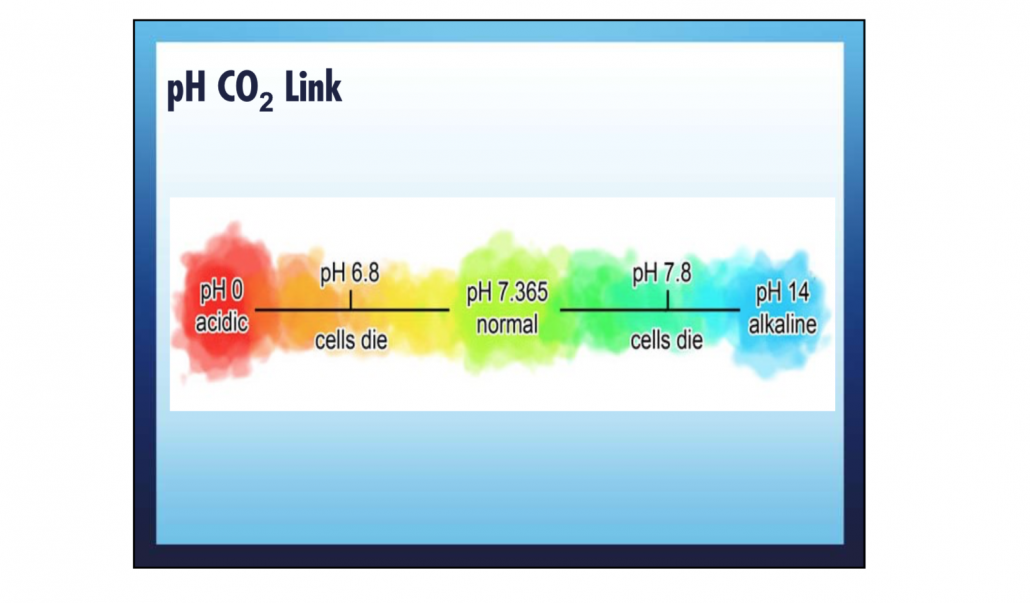
pH-Level or Potentia Hydrogenii!
When we talk about the human respiratory system it is inevitable to talk about our pH-level, it is – depending to different literature – 7.365 and must remain within tightly defined parameters, see picture above. If pH in the blood is too acidic and drops below 6.8 or too alkaline rising above 7.8, death can result (Casiday and Frey)!
To get this straight, pH or pH-level is an abbreviation for the Latin term “potentia hydrogenii”, with Latin “potis” = mighty, powerful, potent and Greek “hydratos” = water (Becher et al., 1995).
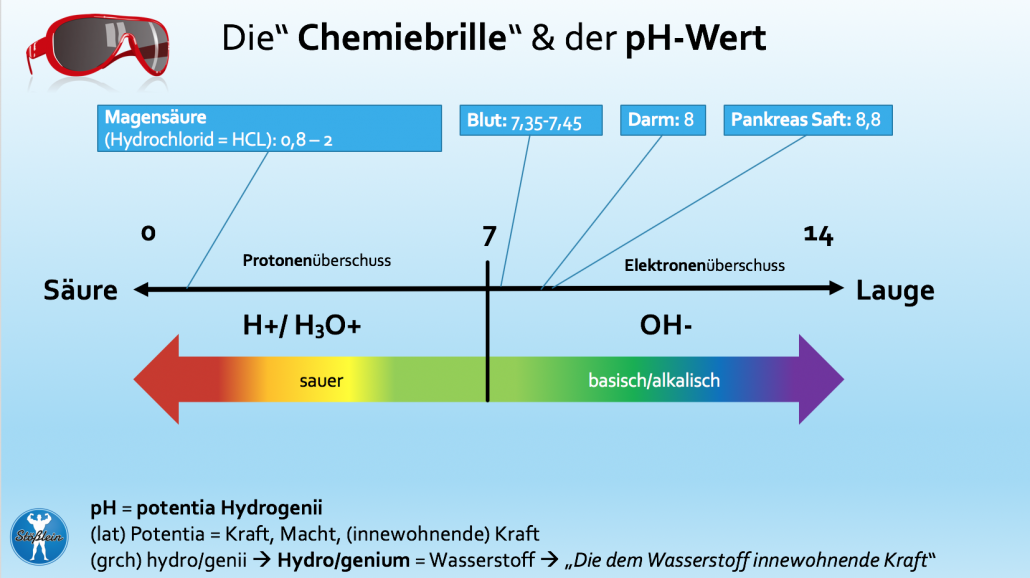
The pH-Level is only something man-made and what I tend to call “wearing chemical glasses” (see picture).
The range goes from 0 to 14, with 0 being the most acidic, 7 being neutral and 14 being the most alkaline.
The picture is in German but it doesn‘t matter as most of the terms are Latin and/or Greek. I give you a translation anyway. The term “Chemiebrille & der pH-Wert” is what I have already described as “the chemical glasses”.
I say chemical as you could also look at the issue of acidity (= “sauer” in German) and alkalinity (= “basisch” in German) from an electronical point of view. To make this very short:
- You are more acidic the more H+ Ions (protons) you have, might lead to respiratory acidosis
- You are more alkaline the more OH- Ions (electrons) you have, might lead to respiratory alkalosis
How NOT TO BREATHE – Respiratory alkalosis & acidosis
Ok, now let us sum up what we have so far. We have done a brief repetition of what O2, CO2, the pH-Level, acidity, alkalinity and even protons (H+) and electrons (OH-) are.
I bring all these together now in terms of breathing and especially what can go wrong with it and when you switch in a state of respiratory alkalosis or respiratory acidosis!
Below you will find a picture of the human respiratory system. As this article is not intended to teach you physiology I try to keep it as simple as possible.
If you breathe in and out you‘re inhaling air (which normally contains about 21% oxygen, 78% nitrogen and a rest of inert gases) and you exhale air (mostly CO2).
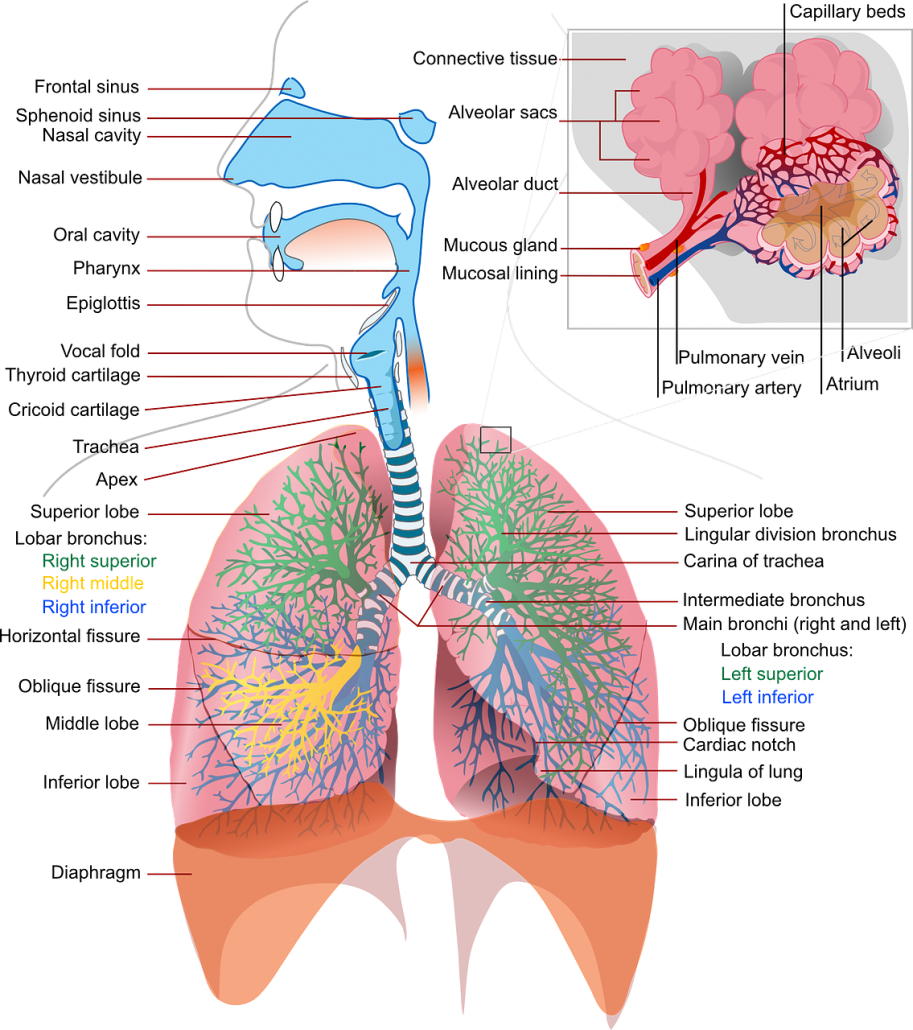
But let‘s say things go a little awkward and you cannot breathe slow, deep and light. Think of some teenage girls being on a concert of their favorite band (whatever that might be).
When these girls are in full admiration of their teeny-band- idol, they might be really excited which could lead to overbreathing. So they are breathing not slow, not deep enough and buy all means probably not light!
They then tend to exhale too much of CO2 (hyperventilation) which will lead to an accumulation of O2! Therefore they are getting more and more alkaline (as they are losing acidity) which might lead to a shift towards alkalinity (see picture of pH-Level) and therefore could cause respiratory alkalosis.
The opposite of hyper/ventilation is, of course, hypo/ventilation. You see, that‘s why I tried not to bore you with the explanation of Latin and Greek terms, but to give you a “toolbox” you can use while getting used to thinking in principles.
Therefore you don‘t have to learn everything by heart. You can simply apply it to different issues.
So, if overbreathing is hyperventilation and means an excessive intake of O2 which might lead to a reduction of CO2 and result in respiratory alkalosis, then hypoventilation must be the lack of O2 and an accumulation of CO2 which might lead to a respiratory acidosis.
And that is basically what the Oxygen Advantage technique is: a hyp/oxic and hyper/capnic state.
Now that you have (re)learned about all those terms you might easily understand what the OA tries to achieve and which biochemical principles are lying behind it. Furthermore, you now can distinguish it from the Wim Hof technique, which is hyp/oxic AND hypo/ capnic!
Now we will look at the biomechanical aspect of some of the main techniques of the OA and breathing itself.
Diaphragmatic Breathing
The OA‘s mission is to teach its students how to switch back from mouth- to nose breathing. To understand how breathing works from a biomechanical point of view we must look at the diaphragm (see picture below).
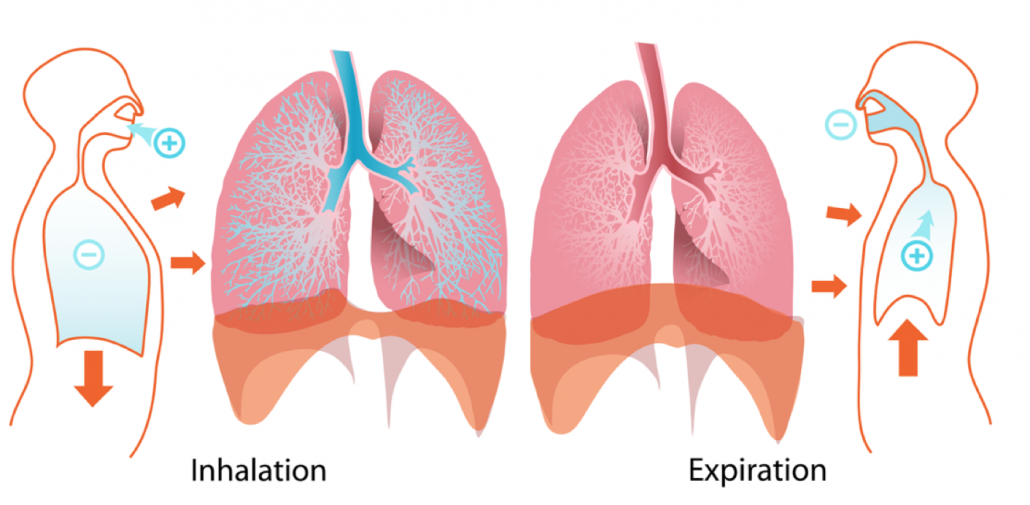
When you look at the picture above you will see that: “ […] “In humans, the diaphragm is slightly asymmetric—its right half is higher up (superior) to the left half, since the large liver rests beneath the right half of the diaphragm. There is also a theory that the diaphragm is lower on the other side due to the presence of the heart.” (Wikipedia, 2019).
Normally,when you breathe, the diaphragm should move downwards (while inhalation) and back up (while expiration). But nowadays lots of people tend to be breathing mostly through their mouth instead of breathing through their nose! This might lead to something that‘s called “Dysfunctional Breathing Patterns”.
Actually there is no precise definition of the term “Dysfunctional Breathing Patterns.
According to McKeown it includes: “any disturbance to breathing including; hyperventilation/over breathing, unexplained breathlessness, breathing pattern disorder, irregularity of breathing.” (McKeown, 2017).
Therefore dysfunctional breathing patterns can include:
- Breathing through mouth
- Hearing breathing during rest
- Regular sighing
- Regular sniffing
- Large breaths prior to talking
- Yawning with big breaths
- Upper chest movement
- Paradoxical breathing
- Noticeable breathing movement during rest
After having shown what can disturb “right” breathing, you surely want to know how you CAN breathe right or at least how you can improve your way of breathing, right? Hang on!
How to improve breathing – Measure your BOLT-Score
Breathing is light, quiet, effortless, soft, through the nose, diaphragmatic, rhythmic and gently paused on the exhale. This is how human beings breathed until the comforts of modern life changed everything, including our breathing. With stress being the bigger influencer, in a negative way!
But how can you estimate how “well” you breath? Measure your BOLT-Score!
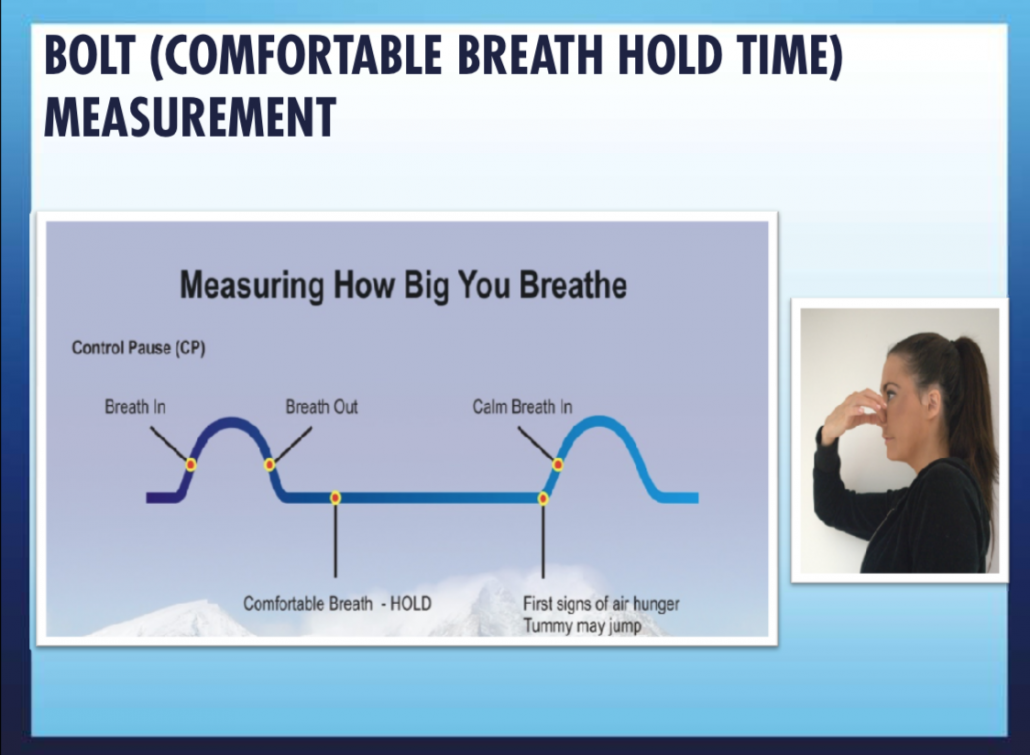
The BOLT-Score is your Body Oxygen Level Test, a breath holding time! So if you want to know how big you breathe you can do so by the following:
- Take a small silent breath in through your nose
- Allow a small silent breath out through your nose
- Hold your nose with your fingers to prevent air from entering your lungs
- Count the number of seconds until you feel the first distinct desire to breathe in
Simple and easy, “et voila” you have measured your BOLT-Score! To keep it easy, anything under 25 seconds leaves a lot of room for improvement! If you‘re an athlete, you‘d better aim for 40 seconds.
Nitric Oxide and the nose
There is one biochemical aspect to nasal breathing I skipped, Nitric Oxide (NO).
It is released in the nasal airways in humans. During inspiration through the nose this NO will follow the airstream to the lower airways and the lungs. Nasally derived NO has been shown to increase arterial oxygen tension and reduce pulmonary vascular resistance, thereby acting as an airborne messenger (Lundberg 2008).
Since NO is continuously released into the nasal airways the concentration will be dependent on the flow rate by which the sample is aspirated. Thus, nasal NO concentrations are higher at lower flow rates (Lundberg and Weitzberg, 1999).
The benefits of nasal breathing
So let us have a look at the benefits of breathing through our nose. Normally it should be quite obvious, I mean it‘s a nose, so what do we think it is supposed to do. But mankind seems to be more and more unsure about what they are or who or what they want to be, or not.
Therefore it is no wonder that we even unlearned to breathe through our nose and used our mouth instead…which obviously is for eating!
Dr. Maurice Cottle who founded the American Rhinologic Society in 1954 said that: “your nose performs at least 30 functions, all of which are important supplements to the roles played by the lungs, heart, and other organs.” (Timmons, 1994).
The nasal cavity has a fundamental role in the physiology of respiration. It promotes filtering, heating and humidification of the inhaled air, causing it to reach the lungs at the ideal temperature and favoring the adequate oxygenation of the body.
According to McKeown nose breathing imposes approximately 50 percent more resistance to the air stream than mouth breathing during wakefulness, resulting in 10-20 percent more O2 uptake, it warms and humidifies incoming air and removes a significant amount of germs and bacteria (McKeown, 2017).
SpO2 – Saturation of Oxygen in your periphery
Measures peripheral oxygen saturation (Spo2) to give a close approximation of the saturation of arterial blood with oxygen (Sao2). What percentage of hemoglobin (Hb) is loaded with O2.
To measure this you need a noninvasive pulse oximeter [affiliate link]. This device will
use two lights- red light and infrared light. Oxygenated hemoglobin absorbs more infrared light and allows more red light to pass through. Deoxygenated hemoglobin allows more infrared light to pass through and absorbs more red light.
Whith this device applying exercises is more accurate as you can measure, and what‘s measurable is manageable!
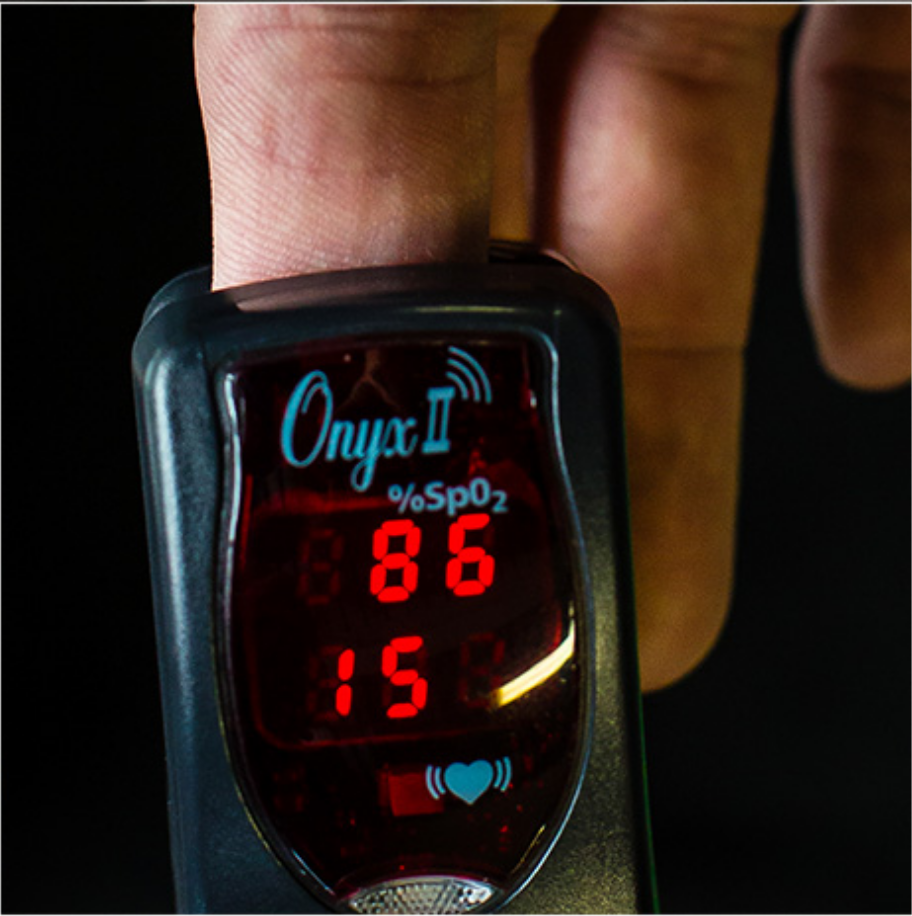
My biggest takeaway
As I mentioned in the introduction of this article I did not only read Patrick‘s book “The Oxygen Advantage” [affiliate link] but also took his Instructor Certification where we had live classes with Patrick himself!
After having successfully passed the exam (yes, there is a mandatory test with over 80 multiple choice questions) and a case study over four weeks with two clients/patients you have to submit I became one of the first certified OA instructors in Germany.
A single blog article is by far not enough to describe everything we have learned during this literally breathtaking seminar and of course I cannot give away all the techniques here for free.
But I will give you a sneak preview at some of the awesome techniques and will tell you MY biggest takeaways. If you are interested in a depth coaching, please send me a mail to: info@bernd-stoesslein.de or if you like to be treated as a patient mail to info@heilpraktiker-stoesslein.de
My biggest takeaways:
- Breathe slow, light but deep (learn to reuse my diaphragm properly)
- Create “air hunger” to get used to less O2 intake and the accumulation of CO2
- Tape my mouth during sleep to increase nose breathing time even during sleep
- Breathe less, reduce my respiratory rate
- Train with my mouth closed only using nasal breathing or use OA “Sportsmask”
- Cadence breathing, in for 4 seconds and breathe out for 6 seconds, keep this cadence over the whole day if possible
A glimpse at one of the exercises
Now I will show you one of the techniques you can start right away with. It is suitable for everyone but please keep in mind that if you have any medical issues or if you are pregnant in the first trimester, please do not do this exercise. Consult a physician first!
The exercise is called:
Warm up with many small breath holds (performed sitting down for 2.5 minutes)
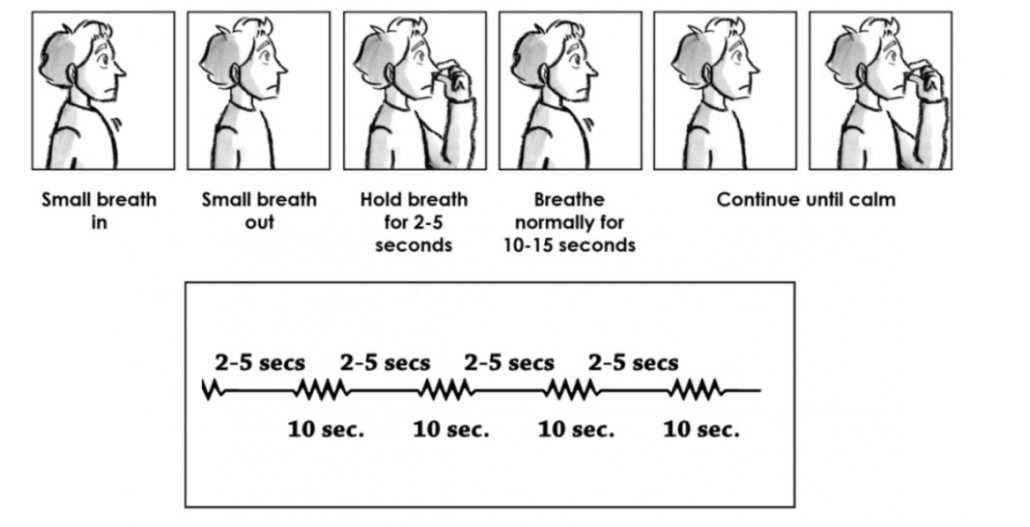
The objective of this exercise is to gently prepare the body for a tolerable feeling of breathlessness. By holding the breath for short periods of time, the gas nitric oxide (NO) slightly pools inside the nasal cavity and the gas carbon dioxide (CO2) slightly increases in the blood. Upon resumption of breathing, breathe in so as to carry NO from the nasal cavity into the lungs. As you hold your breath, you may feel a light hunger for air. This signifies that the gas CO2 is increasing in your blood. Both gases play an important role in opening airways, improving blood circulation and allowing more oxygen to be delivered to the cells. This exercise is ideal for a warm up, to help reduce stress, asthma symptoms and breathing recovery following physical exercise.
Results:
- Introduce air hunger
- Calming exercise in times of stress
- Emergency exercise to help with asthma, panic attack & hyperventilation
Sports Mask, Buyteko Belt and other gadgets
For all the gadget lovers out there, yes, there are Oxygen Advantage gadgets, too. It‘s the “Sports Mask” and a special belt to enhance diaphragmatic breathing, called the “Buyteko Belt”.
And of course it is beneficial to use a pulse oximeter [affiliate link] to measure/monitor your blood oxygen level. For a better ventilation you can also use nasal dilatator [affiliate link] during sleep and during training.
In the picture below you can see me wearing Patrick‘s “Sports Mask” during training, while applying the Oxygen Advantage technique.
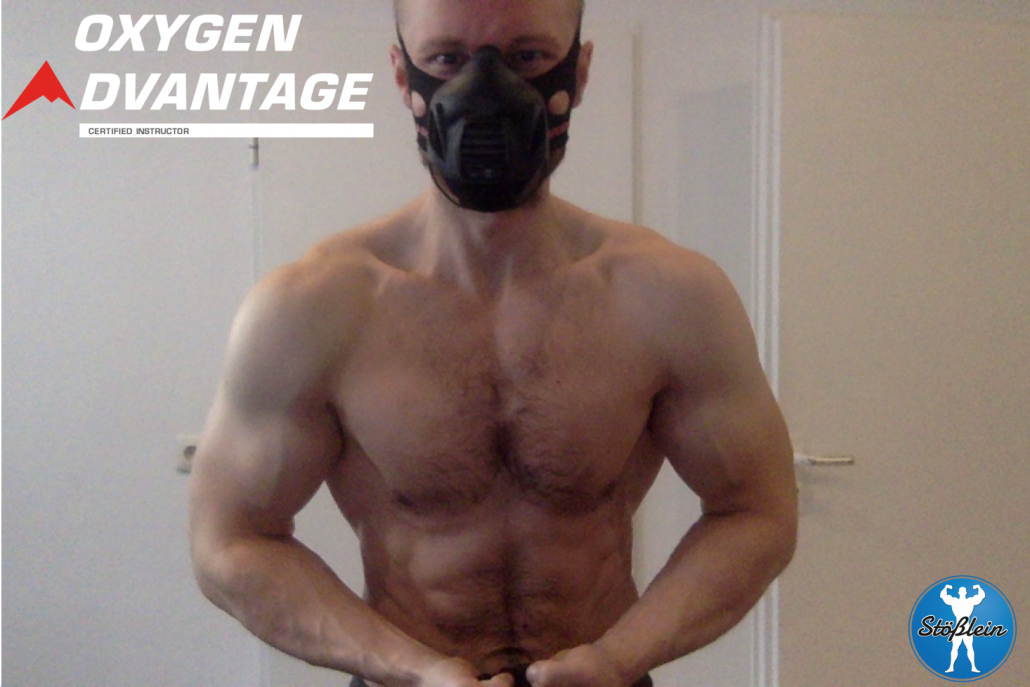
Just another mask for training you think? Think again, cause this one is intended to be used for nasal breathing! I use it to:
- Reduced breathlessness during my training
- Improve my functional breathing
- Improve my aerobic performance
- Strengthen my core and breathing muscles
- Delay onset of fatigue and lactic acid
- Improve my overall fitness level
The next picture shows you another OA device, called the “Buyteko Belt”:
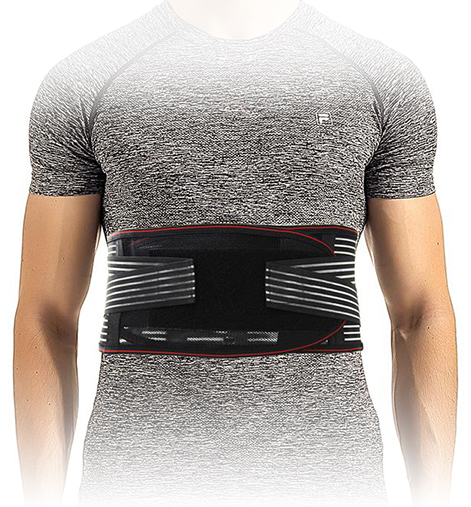
It might be used for:
Achieve an optimized breathing the easy way. May reduce snoring, assist when you suffer from sleep apnea, asthma, stress, anxiety & other breathing related conditions. Enhance and Support your Oxygen Advantage® Practice.
Conclusion
Now this article is intended to be my introduction for you into the world of Patrick McKeown`s Oxygen Advantage. It shows you the basic principles behind this breathing technique and how I do use it for myself to improve not only my physical performance.
As promised, now all the “dots” I gave you might connect and give you a bigger picture of the Oxygen Advantage. The following picture will sum everything up:
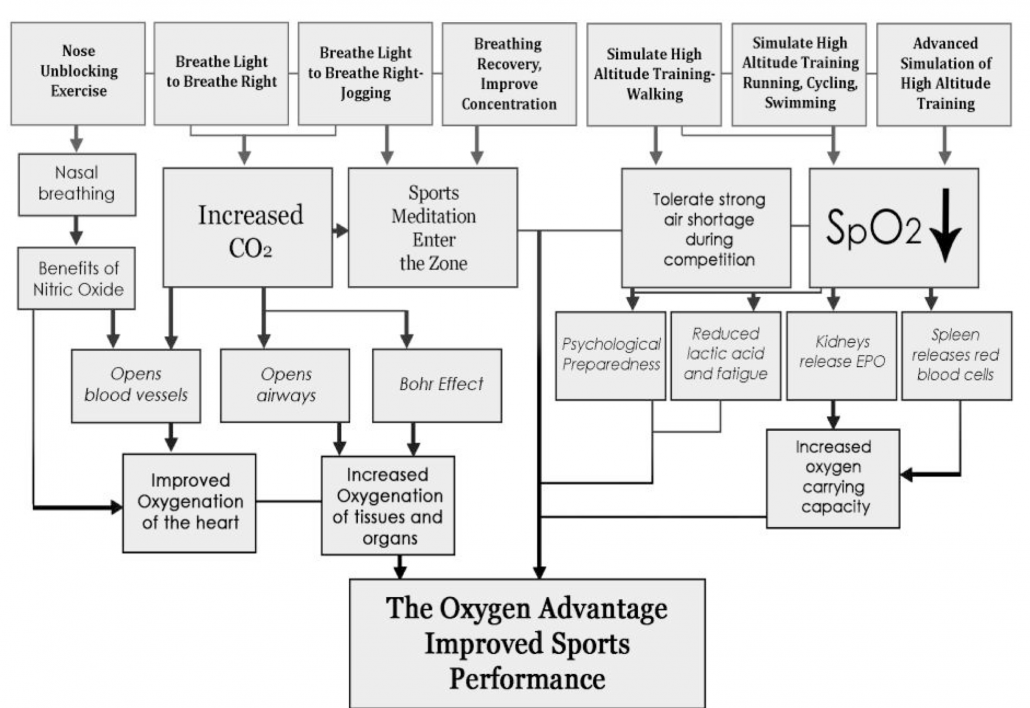
If you liked this article please share it with your friends and leave a comment.
© HP Bernd Stößlein, Master of Business Administration in Sportmanagement.
To get coached, send a mail either to: info@bernd-stoesslein.de or to be a patient to : info@heilpraktiker-stoesslein.de
Disclaimer 1:
The Oxygen Advantage® Workout is perfectly safe for the vast majority of people, however it does include some powerful exercises similar to performing high-intensity interval training. Just as high-intensity exercise is suited only to those with reasonably good health and fitness, those with any medical issues should perform the workout only with the consent of your medical practitioner. Whilst some exercises are challenging they should never feel stressful. Elements of this workout are not suitable if you are pregnant.
Source
Oxygen, source: https://en.wikipedia.org/wiki/Oxygen, access: 7.10.19.
Lateinisch-griechischer Wortschatz in der Medizin, S. 99.
Lateinisch-griechischer Wortschatz in der Medizin, S. 100.
Lateinisch-griechischer Wortschatz in der Medizin, S. 107.
Lateinisch-griechischer Wortschatz in der Medizin, S. 117.
Lateinisch-griechischer Wortschatz in der Medizin, S. 155.
Blood, Sweat, and Buffers: pH Regulation During Exercise Acid-Base Equilibria Experiment Authors: Rachel Casiday and Regina Frey, source, https://pdfs.semanticscholar.org/95eb/035f4395ecd14a2ddefad0f1066bfa6b884b.pdf, access: 7.10.19.
Thoracic Diaphragm, source: https://en.wikipedia.org/wiki/Thoracic_diaphragm acess, 8.10.19.
Lundberg JO. Nitric Oxide and the Paranasal Sinuses. Anatomical Record (hoboken, N.j. : 2007) 2008, 291 (11), 1479–1484 DOI: 10.1002/ar.20782.
Lundberg, J. O. N.; Weitzberg, E. Nasal Nitric Oxide in Man. Thorax 1999, 54 (10), 947–947.
Timmons, B. H.; Ley, R. Behavioral and Psychological Approaches to Breathing Disorders; Plenum Press: New York, 1994.
Disclaimer 2:
All contents of this article are not salutary statements. The diagnosis and treatment of diseases and other physical disorders requires treatment by doctors, naturopaths or therapists. The information in this article is based solely on personal experience and only informative, they should not be used as a substitute for medical treatment. The risk associated with a wrong diagnosis or treatment can only be achieved through the involvement of a medical practitioner, alternative practitioner or be reduced by a therapist. As far as in this article an application, dosage or a specific, medical or nutritional therapy procedure is mentioned, no guarantee can be taken over. Each reader is required to determine, by careful examination and, where appropriate, after consulting a specialist, whether the given recommendations and benchmarks are accurate in the specific case. Any dosage, application or therapy is at the reader’s own risk. The author dissociates himself from any healing statements or promises. From a conventional medical perspective, the effectiveness of the methods is not proven.



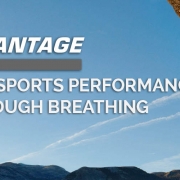


Trackbacks & Pingbacks
[…] more about proper breathing techniques for training, feel free to read my article The Oxygen Advantage®. I’m a certified Oxygen Advantage […]
Dein Kommentar
An Diskussion beteiligen?Hinterlasse uns Deinen Kommentar!